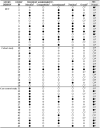NUQUEST-NUtrition QUality Evaluation Strengthening Tools: development of tools for the evaluation of risk of bias in nutrition studies
- PMID: 34605544
- PMCID: PMC8755056
- DOI: 10.1093/ajcn/nqab335
NUQUEST-NUtrition QUality Evaluation Strengthening Tools: development of tools for the evaluation of risk of bias in nutrition studies
Abstract
Background: Dietary exposure assessments are a critical issue in evaluating human nutrition studies; however, nutrition-specific criteria are not consistently included in existing bias assessment tools.
Objectives: Our objective was to develop a set of risk of bias (RoB) tools that integrated nutrition-specific criteria into validated generic assessment tools to address RoB issues, including those specific to dietary exposure assessment.
Methods: The Nutrition QUality Evaluation Strengthening Tools (NUQUEST) development and validation process included 8 steps. The first steps identified 1) a development strategy; 2) generic assessment tools with demonstrated validity; and 3) nutrition-specific appraisal issues. This was followed by 4) generation of nutrition-specific items and 5) development of guidance to aid users of NUQUEST. The final steps used established ratings of selected studies and feedback from independent raters to 6) assess reliability and validity; 7) assess formatting and usability; and 8) finalize NUQUEST.
Results: NUQUEST is based on the Scottish Intercollegiate Guidelines Network checklists for randomized controlled trials, cohort studies, and case-control studies. Using a purposive sample of 45 studies representing the 3 study designs, interrater reliability was high (Cohen's κ: 0.73; 95% CI: 0.52, 0.93) across all tools and at least moderate for individual tools (range: 0.57-1.00). The use of a worksheet improved usability and consistency of overall interrater agreement across all study designs (40% without worksheet, 80%-100% with worksheet). When compared to published ratings, NUQUEST ratings for evaluated studies demonstrated high concurrent validity (93% perfect or near-perfect agreement). Where there was disagreement, the nutrition-specific component was a contributing factor in discerning exposure methodological issues.
Conclusions: NUQUEST integrates nutrition-specific criteria with generic criteria from assessment tools with demonstrated reliability and validity. NUQUEST represents a consistent and transparent approach for evaluating RoB issues related to dietary exposure assessment commonly encountered in human nutrition studies.
Keywords: case-control study; cohort study; nutrition; quality assessment instrument; randomized controlled trial; risk of bias tool.
© Her Majesty the Queen in Right of Canada, as represented by the Minister of Health, 2021.
Figures


Similar articles
-
Reliability of 3 assessment tools used to evaluate randomized controlled trials for treatment of neck pain.Spine (Phila Pa 1976). 2012 Mar 15;37(6):515-22. doi: 10.1097/BRS.0b013e31822671eb. Spine (Phila Pa 1976). 2012. PMID: 21673624
-
Inter-rater reliability of risk of bias tools for non-randomized studies.Syst Rev. 2023 Dec 7;12(1):227. doi: 10.1186/s13643-023-02389-w. Syst Rev. 2023. PMID: 38057883 Free PMC article.
-
Perspective: NutriGrade: A Scoring System to Assess and Judge the Meta-Evidence of Randomized Controlled Trials and Cohort Studies in Nutrition Research.Adv Nutr. 2016 Nov 15;7(6):994-1004. doi: 10.3945/an.116.013052. Print 2016 Nov. Adv Nutr. 2016. PMID: 28140319 Free PMC article.
-
Assessing the quality of prediction models in health care using the Prediction model Risk Of Bias ASsessment Tool (PROBAST): an evaluation of its use and practical application.J Clin Epidemiol. 2025 May;181:111732. doi: 10.1016/j.jclinepi.2025.111732. Epub 2025 Feb 25. J Clin Epidemiol. 2025. PMID: 40010583
-
Validity and Reliability of Pediatric Nutrition Screening Tools for Hospital, Outpatient, and Community Settings: A 2018 Evidence Analysis Center Systematic Review.J Acad Nutr Diet. 2020 Feb;120(2):288-318.e2. doi: 10.1016/j.jand.2019.06.257. Epub 2019 Sep 20. J Acad Nutr Diet. 2020. PMID: 31547992
Cited by
-
The Effect of Dietary Patterns and Nutrient Intake on Oxidative Stress Levels in Pregnant Women: A Systematic Review.Antioxidants (Basel). 2023 Jul 15;12(7):1427. doi: 10.3390/antiox12071427. Antioxidants (Basel). 2023. PMID: 37507965 Free PMC article. Review.
-
Associations between Intake of Dietary Sugars and Diet Quality: A Systematic Review of Recent Literature.Nutrients. 2024 May 21;16(11):1549. doi: 10.3390/nu16111549. Nutrients. 2024. PMID: 38892483 Free PMC article.
-
Evolving Research Focus on Diet and Cardiovascular Disease: A Systematic Review of 298 Cohort Studies Published from 2019 to 2024.Nutrients. 2025 Jun 26;17(13):2126. doi: 10.3390/nu17132126. Nutrients. 2025. PMID: 40647231 Free PMC article. Review.
-
Consumption of Dairy Products and the Risk of Overweight or Obesity, Hypertension, and Type 2 Diabetes Mellitus: A Dose-Response Meta-Analysis and Systematic Review of Cohort Studies.Adv Nutr. 2022 Dec 22;13(6):2165-2179. doi: 10.1093/advances/nmac096. Adv Nutr. 2022. PMID: 36047956 Free PMC article.
-
The Relationship between Whole-Grain Intake and Measures of Cognitive Decline, Mood, and Anxiety-A Systematic Review.Adv Nutr. 2023 Jul;14(4):652-670. doi: 10.1016/j.advnut.2023.04.003. Epub 2023 Apr 19. Adv Nutr. 2023. PMID: 37085091 Free PMC article.
References
-
- Yetley EA, MacFarlane AJ, Greene-Finestone LS, Garza C, Ard JD, Atkinson SA, Bier DM, Carriquiry AL, Harlan WR, Hattis D et al. Options for basing Dietary Reference Intakes (DRIs) on chronic disease endpoints: report from a joint US-/Canadian-sponsored working group. Am J Clin Nutr. 2017;105(1):249S–85S. - PMC - PubMed
-
- National Academies of Sciences, Engineering, and Medicine. Guiding principles for developing Dietary Reference Intakes based on chronic disease. Washington (DC): The National Academies Press; 2017. - PubMed
-
- National Academies of Sciences, Engineering, and Medicine. Dietary Reference Intakes for sodium and potassium. Washington (DC): The National Academies Press; 2019. - PubMed
Publication types
MeSH terms
LinkOut - more resources
Full Text Sources

